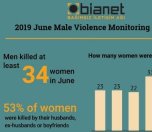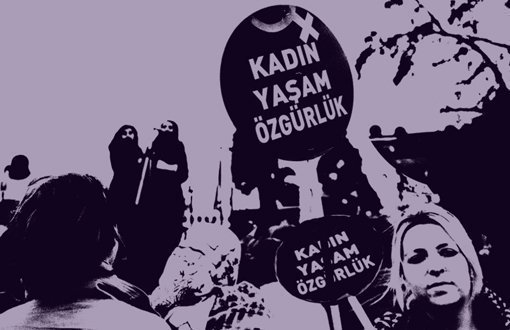Click to read the article in Turkish / Kurdish
According to the news reports bianet compiled from local and national newspapers, news sites and agencies, men killed 23 women, two children and 3 men who intervened in an incident of violence; raped at least two women; harassed 13 women; sexually abused 12 girls; inflicted violence on at least 27 women.
Apart from these incidents of murder and violence, in June;
* The bodies of two women were found.
* One girl from Syria committed suicide.
* One girl attempted to commit suicide.
In the first six months of 2018, men killed at least 120 women and seven children; raped 32 women; harassed 102 women; forced 325 women to sex work; sexually harassed 189 girls; and wounded 212 women.
Murder
In June, men killed 23 women, two children and three men who intervened in an incident of violence. 13 percent of the murders took place in public places such as streets and parks.
Of the 23 women murdered in June, 3 of them were refugees who escaped from war in Syria and settled in Turkey.
48 percent of the women were killed on the ground that they demanded divorce/separation or did not accept the proposal of partnership/reconciliation.
17 percent of the murders were committed despite the applications that the women had made to the police forces or prosecutor's offices.
Of the 23 men who committed femicides in June, two of them were professional soldiers, one of them a police officer and one of them was a private security guard. Three of the femicides were committed by the service pistols of the men.
Three of the murdered women were forced to marriage at an early age; they were killed by their husband when they were 21, 19 and 18 years old.
65 percent of the women were murdered by their husbands; 25 percent of these women got married with a religious ceremony.
12 women were killed by their husbands of civil marriage; three women by their husbands of religious marriage; three women by their boyfriends; two women by their ex-husbands; one woman by the boyfriend of her daughter, from who she wanted to break up; one woman by her son-in-law; and one woman by her relative who wants to get married to her.
48 percent of the women were killed with firearms and 39 percent of them with knives.
Men killed nine women with a knife; seven women with a gun; four women with a riffle; two women by strangling; and one woman by strangling with a cable.
After the femicides, six murderers committed suicide; two of them attempted to do so. Two murderers gave themselves over to the police.
In June, the femicide news came from the following provinces of Turkey: Adana (1), Antalya (2), Antep (2), Bursa (1), Denizli (1), Diyarbakır (2), Edirne (2), Iğdır (1), İstanbul (3), İzmir (1), Kırıkkale (1), Kırklareli (1), Kocaeli (1), Konya (1), Manisa (1), Muğla (1), Nevşehir (1).
Rape
In June 2018, two rape incidents were reported in the media. Both of the women who were subjected to rape were with disabilities.
Judicial process One of the rapists was a man who lives in the same neighborhood with the woman; it was not reported in the news that the two men who raped the other woman were her acquaintances. Two of the three rapists were arrested; the judicial process against the other rapist was not reported in the news. |
Forcing to sex work
In June, 45 women were forced to sex work.
53 percent of the women were not the citizens of Turkey.
Judicial process In the provinces of İstanbul, Antalya and Muğla, one woman and 52 men, 53 people in total, were taken into custody. 22 of the detained were arrested. The judicial process against the 21 people was not reported in the media. |
Harassment
In June 2018, at least 13 incidents of harassment against women were reported in the media.
Almost all of the harassers were male strangers.
38 percent of the women were subjected to exhibitionism, 15 percent of them were subjected to digital harassment.
15 percent of the harassments incidents took place in public transportation and 23 percent of them at public toilettes.
Two of the harassers have previous criminal records on charges such as harassment and exhibitionism.
Judicial process Of 15 harassers, two of them were arrested due to harassment. One harasser was arrested on the ground that he stabbed a person who intervened in the incident. No judicial process was launched against two harassers, one of whom had a previous criminal record of harassment. One of them was released after giving his deposition, three harassers were released on probation. The judicial process after the detention of four harassers was not reported in the media. It was reported in the news that two harassers escaped. |
Child abuse
In June, 72 men sexually abused 12 girls.
Two girls got pregnant due to the sexual abuse.
Two of the children were abused by their relatives; two children by their neighbors; one child by the husband of her sister; one child by the relative of her friend; one child by her boyfriend; and one child by her stepfather.
One abuser was previously sentenced on charge of child abuse and was released on probation in 2013.
Judicial process Of the 72 abusers, 12 of them were arrested. 16 abusers were released on probation. As for the 44 abusers, it was only reported in the media that they were taken into custody. Three child abuse incidents were revealed after they talked to their mothers. One incident was uncovered after the teachers of the child got suspicious by her behavior. It was understood at hospital that two girls were pregnant. |
Violence
Men inflicted violence on 27 women in June. At least five women were seriously injured. One transwoman was subjected to a lynch attempt on the street.
Two of the women subjected to violence were refugees.
15 percent of the women were inflicted violence because they demanded separation/divorce. 11 percent of the women were inflicted violence despite the decisions of protection measure.
37 percent of the violence incidents happened in public places. A man that attempted to run over his wife who demanded divorce in front of the courthouse was released after giving his deposition.
55.5 percent of the women were inflicted violence by their husbands:
14 women were subjected to violence by their husbands of civil marriage; one woman by her husband of religious marriage; one woman by her ex-husband; three women by their boyfriends; two women by men, whom they know from their workplace; one woman by her son-in-law; three women by their sons; one woman by the driver of the taxi that she got on; and one woman by a male stranger.
44 percent of the women were subjected to serious violence:
Men injured four women by driving their cars over them; one women with an axe; one woman with a knife; one woman by strangling; two women through battery with objects; 12 women through battery; one woman by torture; and one woman by hydrochloric acid. One taxi-driver inflicted verbal violence one her woman guest by throwing her belongings on the street. One man took his wife hostage; the woman escaped by jumping off the balcony and broke her backbone. Another man took his wife hostage and set her store to fire.
Judicial process Of the 26 offenders, only five of them were arrested due to the violence that they inflicted on women. One offender was arrested after he stabbed his relative, who attempted to intervene in the incident of violence, to death. One offender was killed by the woman, whom he had inflicted violence, and one offender was killed by the son of the woman, whom he subjected to violence. One offender was released on probation. Two offenders were released after giving their deposition. The working license of one taxi-driver, who inflicted violence on her woman guest, was cancelled. In an incident, where a transwoman faced a lynch attempt, it was reported that 'some of the attackers were seized', but no further details were shared. The judicial process against 12 offenders was not reported in the news. |
(ÇT/SD)
Explanation The bianet Male Violence Monitoring Report only covers women who lost their lives as a result of male violence. We do not take include any violence cases or crimes that are not gender-based. Throughout the year, we keep track of unidentified murders and suspicious deaths of women in separate monthly tallies but do not add them to the number presented in the headline. At the end of the year, we examine these cases of unidentified murders and suspicious deaths to determine whether the crimes were gender-based. In time, when we come to the conclusion that a crime is gender-base, we include it in the end-of-year tally. We do not include any murders in the reports that are committed by people with psychological disorders (such as murders committed by people with schizophrenia). In addition, we don't include femicide cases that occur in a mass murder in which the woman was not directly targeted under the condition that the debated incident is not gender based either. For example, following case from June 11, 2017 was not included in our male violence report: * A.K. (27), a rancher in Konya province killed his relatives Bekir Kıran (80/male), Mustafa Tokat (80/male), Meryem Tokat (79/female), Hamit Tokat (51/male) and Mehmet Tokat (64/male) with a barreled-gun. He was caught on the way home after committing the murders. It was reported, that A.K. had schizophrenia and considered the villagers responsible for the death of his father, who had lost his life after a heart attack. The occupational groups mentioned in the report, only cover cases in which the occupations have relevance for the act of violence. * Example: "The expression "x% of the rapists were drivers",imply that the woman was raped by the driver of the (public) transportation vehicle she used. |







.jpg)



